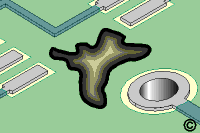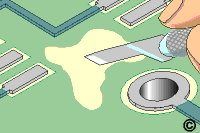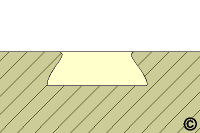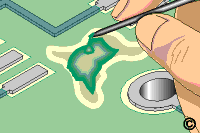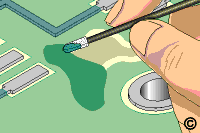No. 3.5.1
Base Material Repair, Epoxy Method
OUTLINE
This procedure is used to repair minor damage to circuit base board material. Scrapes
and scratches in the base board material may be caused by accidents during
handling. Burns in the base material may be caused by improper use of soldering
and desoldering tools.
CAUTION
This method may be used when the damage extends deep into the base material, but
not completely through. If the base board material is damaged completely
through, see Procedure No. 3.5.2 or 3.5.3.
CAUTION
Surface circuits may need to be replaced in the damaged area. Be sure that the
appropriate circuit diagrams, or photographs reflecting the original circuits
are available so that they may be replaced after repairing the base board
material. Damage to internal circuits or planes may have to be restored using
surface wires.
TOOLS & MATERIALS
Ball Mills
Base Board Repair Kit
Cleaner
Color Agents
Epoxy
Foam Swabs
Knife
Micro-Drill System
Microscope
Oven
Scraper
Tape, Kapton
Wipes
PROCEDURE
- Clean the damaged area.
- Scrape away the damaged base board material using a knife. All
damaged base board material and solder mask must be removed at the surface. (See
Figure 1).
or
Mill away the damaged base board material using the Micro-Drill System and ball
mill. All damaged base board material and solder mask must be removed. (See
Figure 2).
NOTE
To clearly see that all damaged material has been removed, flood the area with
alcohol or solvent. Damaged internal fibers of the base material will show up
clearly.
CAUTION
Abrasion operations can generate electrostatic charges.
NOTE
An undercut to enhance mechanical strength may be desired for class 3 product.
(See figure #3).
- Remove all loose material and clean the area.
- Where needed, apply Kapton tape to protect exposed parts of circuit
board.
NOTE
The circuit Board may be preheated prior to filling the area with epoxy. A preheated
PC board will allow the epoxy to easily flow and level out. Epoxy applied to an
unheated circuit board may settle below the circuit board surface as the epoxy cures.
- Mix the epoxy. If desired, add color agent to the mixed epoxy to match the
PC board color.
- Fill the area with epoxy up to and flush with the circuit board surface. No
fibers of laminate material should be exposed. A mixing stick sharpened at the
end may be used to apply and spread the epoxy. For large areas, apply the epoxy
with a foam swab to create a texture in the surface. (See Figures 4 and 5).
NOTE
A slight overfill of epoxy may be desired to allow for shrinkage when epoxy
cures.
NOTE
Epoxy may be applied using a foam swab to restore the surface appearance.
- Cure the epoxy per Procedure 2.7 Epoxy Mixing and Handling.
CAUTION
Some components may be sensitive to high temperature.
- After the epoxy has cured remove the Kapton tape.
- If needed, use a knife or scraper and scrape off any
excess epoxy. Scrape until the new epoxy surface is level with the surrounding
PC board surface.
- Remove all loose material. Clean the area
NOTE
If needed, apply an additional thin coating to seal any scraped areas.
EVALUATION
- Visual examination for texture and color match.
- Electrical tests to conductors around the repaired area as applicable.
|


